An option to buy granted to a tenant
A landlord grants a tenant an option to purchase by entering into an irrevocable right to buy the property, called an option to buy.
The option to buy is typically evidenced by a separate agreement attached to the lease agreement. An option to buy includes the terms of purchase, none of which are related to the leasehold estate the tenant holds in the property. The option to buy is always referenced in the lease agreement and attached as an addendum. [See RPI e-book Real Estate Property Management, Chapter 6]
An option to buy contains all terms needed to form an enforceable purchase agreement for the acquisition of the real estate when the buyer exercises the option. [See RPI Form 161]
The tenant holding an option to buy has the discretionary right to buy or not to buy on the sales terms stated in the option. To exercise the option, the tenant does so within an agreed-to time period. No variations are allowed for enforcement.
Thus, the option is a purchase agreement offer irrevocably agreed to by the owner to sell, but the tenant has not agreed to buy. To agree to buy the property under an option, the tenant exercises their right to buy through an acceptance of the irrevocable offer to sell granted by the option.
The option agreement
Under an option to buy agreement, the tenant is not obligated to buy the leased property. The tenant is merely given the right to buy by a later timing exercise of the option. This is a type of call option. [See RPI Form 161]
For the option to be enforceable, the purchase price of the property and terms of payment on exercise of the option are included in the option agreement. The consideration given the owner by the tenant for the grant of the option is the tenant’s execution of the lease agreement. Option money is not also needed. [See RPI Form 161 §9]
When the dollar amount of the price is not set as a specific dollar amount in the option agreement, the purchase price may be stated as the fair market value (FMV) of the property at the time the option is exercised.
The right to buy is exercised by the tenant within a specified time period, called the option period. The option period typically runs until the lease expires or is terminated, including extensions/renewals. [See RPI Form 161 §4]
When the option is not exercised precisely as agreed during the option period, the option period expires of its own accord — no further notice or documentation is needed.
On expiration of the option, the option no longer exists, and the tenant is without an enforceable right to acquire the property. [Bekins Moving & Storage Co. v. Prudential Insurance Company of America (1985) 176 CA3d 245]
When options to renew or extend leasing periods are negotiated as part of the leasing arrangements, the expiration of the option to buy is tied by agreement to either:
- the expiration of the initial lease term; or
- the expiration of any renewal, extension or continuation of the tenant’s lawful possession.
Related article:
Form-of-the-Week: Option and Exercise of Option to Renew/Extend a Lease — Forms 565 and 566
A right of first refusal differs from an option to buy
A right of first refusal is a contractual pre-emptive right held by a person to buy a property in the event the owner later decides to sell it.
The right of first refusal is often confused with an option to buy as they share similar characteristics.
Recall that an option to buy is an irrevocable right held by a person, typically a tenant, to purchase a property for an agreed-to price during a specified period of time.
In contrast, a right of first refusal, though similar, refers to an opportunity held by person, often a tenant, to purchase the property in the event the owner, such as the landlord, decides to sell it prior to the right expiring.
Further, when a third party offers to buy the property and the owner agrees to sell, a right of first refusal also provides the person holding the preemptive right with the ability to purchase the property on the same price and terms offered by the third party and accepted by the owner.
The right of first refusal is a short agreement with its provisions either included in the body of the lease agreement or by an addendum. Unlike the option to buy, the right of first refusal rarely contains any terms of a sale and does not need to for enforcement. [See RPI Form 579]
Related video:
Breaking down the irrevocable right to buy
A leasing or sales agent uses the Standard Option to Purchase — Irrevocable Right-to-Buy agreement published by Realty Publications, Inc. (RPI) when offers to rent or buy a property include a purchase option with a single time period for exercise. The form allows the leasing or sales agent to prepare an option as an irrevocable offer granted by the owner to sell a property at a price and on terms for payment exercisable during a single time period. The option form is attached as an addendum to a lease agreement or an offer to grant an option. [See RPI Form 161]
The Standard Option to Purchase — Irrevocable Right-to-Buy contains the following sections:
- Option money: a fee paid by the buyer as the optionee, to the seller as the optionor, in exchange for the exclusive right to purchase the property within the specified time period [See RPI Form 161 §1];
- Real property under option: the address or legal description of the real estate [See RPI Form 161 §2];
- Additional consideration: a checklist for selection of items the buyer is to obtain and deliver to the seller as further consideration for the grant of the option [See RPI Form 161 §3];
- Option period: the seller grants to the buyer an irrevocable option to purchase the seller’s right, title and interest in the property on the terms stated, for a period commencing with the acceptance of the option through its expiration [See RPI Form 161 §4];
- Exercise of option: the steps and methods the buyer is to use to exercise the option during the option period [See RPI Form 161 §5];
- Escrow contract: the escrow company to be used and how many days it will take escrow to close [See RPI Form 161 §6];
- Delivery of title: actions the seller needs to take for escrow to close [See RPI Form 161 §7];
- Brokerage fee: the amount and terms for payment of the broker’s earned fee [See RPI Form 161 §8];
- Sale terms: the real estate price and how it’s paid [See RPI Form 161 §9];
- General provisions: the mandated disclosures the seller is to provide to the buyer [See RPI Form 161 §10];
- Expiration of option: a specific date on which the option expires [See RPI Form 161 §11]; and
- Signatures of the seller, buyer, seller’s broker and buyer’s broker. [See RPI Form 161]
Breaking down the option to purchase with extensions to time for exercise
A buyer’s agent uses the Option to Purchase with Extensions — Irrevocable Right-to-Buy published by RPI when the buyer’s offer is for acquiring a purchase option with extensions for additional time to exercise. The form is used by an agent to prepare an option as an irrevocable offer to sell at a price and on terms for payment exercisable during an initial period or extensions of time, which is attached to an offer to grant an option. [See RPI Form 161-1]
The Option to Purchase with Extensions — Irrevocable Right-to-Buy contains the following sections:
- Option money: the dollar amount the seller will receive from the buyer as consideration for the option [See RPI Form 161-1 §1];
- Real property under option: an address and legal description of the real estate which is the subject of the option [See RPI Form 161-1 §2];
- First option period: the expiration of the extended option period [See RPI Form 161-1 §3];
- Second option period: a second option period commencing on expiration of the initial option period is granted on delivery of additional consideration [See RPI Form 161-1 §4];
- Third option period: a third option period commencing on expiration of the second option period is granted on delivery of additional consideration [See RPI Form 161-1 §5];
- Additional extensions: further monthly extensions following the third option period are granted on delivery of additional consideration [See RPI Form 161-1 §6];
- Exercise of option: the activities the buyer must perform to exercise the option [See RPI Form 161-1 §7];
- Escrow contract: the escrow company to be used and how many days it will take escrow to close [See RPI Form 161-1 §8];
- Delivery of title: actions the seller needs to take for escrow to close [See RPI Form 161-1 §9];
- Sale terms: the price of the real estate and the terms for payment of the price [See RPI Form 161-1 §10];
- General provisions: the disclosures the seller is to provide to the buyer [See RPI Form 161-1 §11];
- Expiration of option: the expiration date beyond which the option cannot be exercised [See RPI Form 161-1 §12];
- Brokerage fee: the amount and terms for payment of the broker’s earned fee [See RPI Form 161-1 §13]; and
- Signatures of the seller, buyer, seller’s broker and buyer’s broker. [See RPI Form 161-1]
Breaking down the assignment of option to buy
Agents and escrow officers handling the sale of an option to buy property, typically held by a tenant or a prospective buyer as the Optionee, use the Assignment of Option to Buy published by RPI to transfer the option rights when the Optionee sells their right to buy the property interest described in the option to another person, called the assignee who is acquiring the option rights.
The assignment form identifies the option to buy document by its date, the optionor who owns the property and granted the option, the optionee now selling their option rights to buy the property, the description of the property under option and any recording information related to the option to buy.
The form also identifies the participants to the assignment of the option as the Optionee assigning their rights to buy, and the Assignee who is acquiring the option rights to buy the property. [See RPI Form 161-2]
The Assignment of Option to Buy contains the following sections:
- Facts: the date of the option to buy, the Optionor who owns the property which is the subject of the option, Optionee who originally acquired the option rights, and a description of the property and any recording information [See RPI Form 161-2 §1];
- Agreement: the Optionee assigns their rights under the option to the Assignee acquiring the rights who agrees to perform all of the Optionee’s obligations under the option to buy [See RPI Form 161-2 §§2 and 3]; and
- Signatures of the seller and buyer. [See RPI Form 161-2]
The Assignment of Option to Buy needs to be notarized when the assignment is to be recorded. [See RPI Form 161-2]
Want to learn more about the option to buy? Click the image below to download the RPI book cited in this article.


















